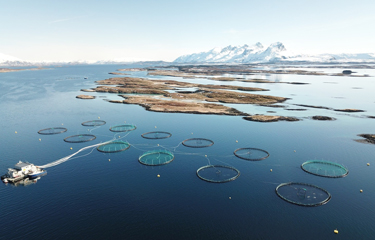The impact of COVID-19 lockdown measures on the foodservice industry, with the overall demand for farmed Atlantic salmon falling, led Bergen, Norway-headquartered Mowi to post lower operational earnings before interest and taxes (EBIT) of EUR 80.4 million (USD 93.9 million) for the third quarter of this year, some EUR 67.4 million (USD 78.7 million) less than it achieved in the corresponding period of 2019.
According to its latest results statement, the fish farming group’s operational revenues for the last quarter totaled EUR 958 million (USD 1.1 billion), down from just over EUR 1 billion (USD 1.2 billion) in Q3 2019. In line with its previous guidance, the total harvest volume for the three months was 125,773 metric tons (MT) gutted weight, up from 116,989 MT in Q3 2019.
Its tonnage forecast for 2020 is 442,000 MT, increasing to 445,000 MT for 2021.
“Our operations have been running close to normal despite further COVID-19 restrictions in the quarter. However, the pandemic still impacts out of home consumption to a large degree, and although retail sales are strong, our earnings are impacted by falling prices as a result of lower net demand,” Mowi CEO Ivan Vindheim said.
Vindheim also highlighted that mowi’s farming, feed, and consumer products divisions delivered all-time high quarterly volumes.
“Mowi’s integrated value chain has yet again demonstrated its strength during these unprecedented times. It is also encouraging to see that farming production cost has improved,” he said.
While its farming volumes have grown significantly over the past few years, Mowi acknowledged that it has been lagging behind the industry’s farming volume growth trajectory. As such, it intends to put even more focus on growing farming volumes going forward, with details to be shared on its capital markets day on 17 March 2021.
“Global supply growth in 2021 is expected to be 1 percent and would under normal circumstances be very supportive of strong salmon prices. Whilst COVID-19 has significantly impacted the salmon market and prices in the short-term, we still strongly believe in the positive long-term outlook for the industry, and for Mowi in particular,” Vindheim said.
With regard to its salmon farming operations, Mowi’s salmon of Norwegian origin achieved an operational EBIT per kilogram of EUR 0.87 (USD 1.02) in the last quarter, down from EUR 1.64 (USD 1.92) in Q3 2019. Mowi’s salmon of Scottish, Chilean and Faroese origin also reported lower operational EBITs per kilogram of EUR 0.35 (USD 0.41), EUR 0.56 (USD 0.65), and EUR 1.27 (USD 1.48) respectively, while its Irish salmon increased to EUR 1.87 (USD 2.18) per kilogram. Its Canadian operations actually notched a loss of EUR 0.56 (USD 0.65) per kilo in operational EBIT.
Mowi’s consumer products division continued to benefit from the shift in demand from foodservice to retail due to the global lockdown measures, and delivered all-time high sales volumes and results for a third quarter. The segment’s operational EBIT totaled EUR 21.2 million (USD 24.8 million), while its revenues reached EUR 648.1 million (USD 757 million). The total volume sold was 60,539 MT.
Mowi’s feed segment reported an operational EBIT of EUR 12.4 million (USD 14.5 million), up from EUR 7.9 million (USD 9.2 million) a year previously, with 143,273 MT produced, and 171,319 MT sold.
Mowi’s results statement also divulged that the global supply of salmon increased by 4.8 percent in the last quarter to 641,300 MT gutted weight, which it said was in line with expectations. While Chile provided more salmon, Mowi noted the supply from Norway was lower than expected. Norway contributed 322,500 MT to this total (up 0.5 percent), Scotland produced 48,700 MT (down 3.4 percent), Chile generated 184,100 MT (up 15.6 percent), and North America supplied 37,900 MT (up 1.3 percent).
In market currencies, European prices decreased by 11 percent compared with the third quarter of 2019. In the United States, salmon prices fell by 21 percent in Miami, 16 percent in Seattle, and 7 percent in Boston and New York. Consumption in the European Union increased by 7 percent in the quarter, in line with lockdown measures easing and many markets experiencing improved foodservice demand. Meanwhile, U.S. consumption increased by 14 percent with strong retail, online, and in-store pick-up sales overcoming a partial closure of the foodservice segment.
Conversely, consumption in Asia decreased by 10 percent in the same period, despite improved airfreight capacity and reduced freight rates compared to the second quarter.
Photo courtesy of Mowi







